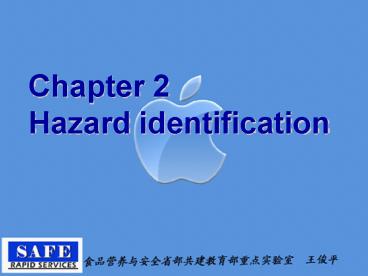Hazard identification
1 / 19
Title: Hazard identification
1
Chapter 2 Hazard identification
2
What is toxicology?
- Toxicology-the science of poisons
- Adverse effects of chemicals or physical agents
on living organisms - Organ/cell/biochemical pathway
3
Basic Terms
- Toxicityintrinsic capacity of a chemical to
induce injury (adverse effect) - Hazardthe possible threat to you and possible
negative health outcomes under the known exposure
conditions.
4
Definitions
- Hazard identification(????)identification from
animal and human studies of adverse effects
associated with exposure to an agent. - Hazard characterisation (????) consideration of
results of hazard ID phase in relation to dose
used.
5
Definitions
- Dose-response(????)relationship between
- magnitude of dose and incidence or severity of
- adverse effect
- Threshold(??)owest dose which causes an
- effect
- NOEL-highest dose employed at which no effect was
observed - LOEL-lowest dose at which there was an observed
effect - ThresholdltLOEL but gtNOEL
6
Examples of different hazards
- Clostridium botulinum toxin-extremely toxic on
nervous system (Acute) - Endosulfan-acute (acute-acetylcholinesterase
inhibition) or chronic toxicity (kidney tubules) - Heterocyclic amines (barbecued meats)-Carcinogenic
7
When is a hazard a risk?
- The bodies adaptive mechanisms cannot cope
- Clinical, chemical, histopathological changes
occur - Effect is irreversible
- For food, risk of acute exposure rare, therefore,
pay particular attention to chronic exposure
(hence ADI)
8
Hazard Assessment (Why?)
- Understanding what are the concerns about the
chemical - Is it likely to cause health problems?
- eg, acute toxicity, cancer, kidney damage
- Understanding the dose-response relationship
- - is it a problem at low doses?
- - is it a problem at high doses only?
9
Hazard Assessment
Epidemiological data - less precise - highly
relevant
- Animal toxicity data
- more precise
- less relevant
- OUTCOMES
- Some understanding of kinetic and metabolism
- Identify target organs
- Possible mechanism of action
- Dose-response relationship
- Evidence of a threshold/NOEL
NOEL No Observed Effect Level
10
Considerations
- Highest dose should not exceed gt5 of total
diet?nutritional imbalances - Do not want severe/extreme toxic effects that
compromise the duration or results of the study
?uncertainties - Controls-concurrent, negative/positive,
historical, vehicle
11
Considerations
- Validity of older studies
- Species-specific effects
- Statistical versus biological significance
- Limit dosing versus three doses
- Weight of evidence-judgement, adequacy, validity
and appropriateness of data base.
12
ConsiderationsPhysiological, Pharmacological or
Toxic?
- Physiology
- Variation within limits of normal function
(pregnancy leads to increased bodyweight) - Pharmacology
- Altered physiology through interaction with
receptor site, reversible (chemical increase
activity of liver enzymes)
13
Considerations Physiological, Pharmacological or
Toxic?
- Toxicology
- Reversible/irreversible Injurious and therefore
adverse and harmful - A chemical which causes physiological or
pharmacological effects could produce toxic
response with long and/or high levels of exposure
14
Remember
- All substances are hazardous under certain
conditions of exposure (we are looking at the
oral route for food) - Sometimes need only small amounts for it to be a
hazard (eg less than a drop) therefore, toxicity
is a function of amount received - Dose is very important (to be discussed later)
15
What can studies tell us?
- That the chemical can in fact be a hazard-it has
an adverse effect at a particular dose - Lowest dose ( threshold)
- No effect or lowest effect level
- Is there a dose-response effect?
- Allows certain key toxicological parameters
(endpoints) to be calculated
16
Toxicological endpoints
- Toxicological endpoints-as increase dose reach a
level at which a definite adverse effect is
observed-e.g neurotoxicity, increase liver
weights, optic nerve degeneration etc
17
Example Neotame
- New food additive - intense sweetener
- Expected to be used widely in food high
population exposure - Studies required (pre-market assessment)
Metabolism and kinetic studies, short and
long-term studies, reproduction and developmental
studies, studies on metabolites, genotoxicity
studies, human toleration studies
- Proposed use level in food
18
Example New Insecticide
- Widespread agricultural and home use high
population exposure - Safety studies required (pre-market assessment)
Metabolism and kinetic studies, short and
long-term studies, reproduction and developmental
studies, studies on metabolites, genotoxicity
studies (no human studies)
19
Summary
- Hazard identification-?adverse effect (?liver
changes vs neurotoxicity) - Range toxicology studies used to determine hazard
- Toxicological endpoints, threshold, NOEL, LOEL































